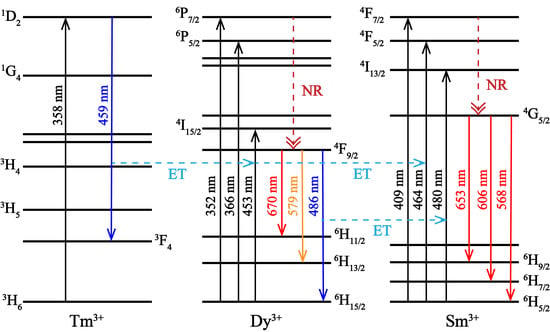Multiple Energy Transfer in Luminescence-Tunable Single-Phased Phosphor NaGdTiO4: Tm3+, Dy3+, Sm3+
Abstract
:1. Introduction
2. Material Synthesis and Characterization
3. Results and Discussion
3.1. Phase Composition and Morphologies
3.2. PL Properties of NGT: Dy3+, NGT: Tm3+, and NGT: Sm3+
3.3. PL Properties and Energy Transfer Behavior of NGT: Tm3+/Dy3+/Sm3+
4. Conclusions
Supplementary Materials
Author Contributions
Funding
Conflicts of Interest
References
- Feldmann, C.; Jüstel, T.; Ronda, C.R.; Schmidt, P.J. Inorganic Luminescent Materials: 100 Years of Research and Application. Adv. Funct. Mater. 2003, 13, 511–516. [Google Scholar] [CrossRef]
- Lee, S.-W.; Seo, J.M.; Lee, M.-K.; Chun, J.-H.; Antonisamy, P.; Arasu, M.V.; Suzuki, T.; Al-Dhabi, N.A.; Kim, S.-J. Influence of different LED lamps on the production of phenolic compounds in common and Tartary buckwheat sprouts. Ind. Crops Prod. 2014, 54, 320–326. [Google Scholar] [CrossRef]
- Rodríguez-Vidal, E.; Otaduy, D.; Ortiz, D.; González, F.; Moreno, F.; Saiz, J.M. Optical performance of a versatile illumination system for high divergence LED sources. Optik 2014, 125, 1657–1662. [Google Scholar] [CrossRef]
- Rosemann, N.W.; Eußner, J.P.; Beyer, A.; Koch, S.W.; Volz, K.; Dehnen, S.; Chatterjee, S. A highly efficient directional molecular white-light emitter driven by a continuous-wave laser diode. Science 2016, 352, 1301–1304. [Google Scholar] [CrossRef] [PubMed]
- Nishida, T.; Ban, T.; Kobayashi, N. High-color-rendering light sources consisting of a 350-nm ultraviolet light-emitting diode and three-basal-color phosphors. Appl. Phys. Lett. 2003, 82, 3817–3819. [Google Scholar] [CrossRef]
- Kim, J.S.; Jeon, P.E.; Park, Y.H.; Choi, J.C.; Park, H.L.; Kim, G.C.; Kim, T.W. White-light generation through ultraviolet-emitting diode and white-emitting phosphor. Appl. Phys. Lett. 2004, 85, 3696–3698. [Google Scholar] [CrossRef]
- Kang, Y.C.; Lenggoro, I.W.; Park, S.B.; Okuyama, K. YAG:Ce phosphor particles prepared by ultrasonic spray pyrolysis. Mater. Res. Bull. 2000, 35, 789–798. [Google Scholar] [CrossRef]
- Pan, Y.; Wu, M.; Su, Q. Comparative investigation on synthesis and photoluminescence of YAG:Ce phosphor. Mater. Sci. Eng. B 2004, 106, 251–256. [Google Scholar] [CrossRef]
- Pan, Y.; Wu, M.; Su, Q. Tailored photoluminescence of YAG:Ce phosphor through various methods. J. Phys. Chem. Solids 2004, 65, 845–850. [Google Scholar] [CrossRef]
- Narukawa, Y.; Niki, I.; Izuno, K.; Yamada, M.; Murazaki, Y.; Mukai, T. Phosphor-conversion white light emitting diode using InGaN near-ultraviolet chip. Jpn. J. Appl. Phys. Part 2-Lett. Express Lett. 2002, 41, L371–L373. [Google Scholar] [CrossRef]
- Sheu, J.K.; Chang, S.J.; Kuo, C.H.; Su, Y.K.; Wu, L.W.; Lin, Y.C.; Lai, W.C.; Tsai, J.M.; Chi, G.C.; Wu, R.K. White-light emission from near UV InGaN-GaN LED chip precoated with blue/green/red phosphors. IEEE Photonics Technol. Lett. 2003, 15, 18–20. [Google Scholar] [CrossRef]
- Huang, C.-H.; Chan, T.-S.; Liu, W.-R.; Wang, D.-Y.; Chiu, Y.-C.; Yeh, Y.-T.; Chen, T.-M. Crystal structure of blue–white–yellow color-tunable Ca 4 Si 2 O 7 F 2: Eu 2+, Mn 2+ phosphor and investigation of color tunability through energy transfer for single-phase white-light near-ultraviolet LEDs. J. Mater. Chem. 2012, 22, 20210–20216. [Google Scholar] [CrossRef]
- Li, L.; Zi, W.; Li, G.; Lan, S.; Ji, G.; Gan, S.; Zou, H.; Xu, X. Hydrothermal synthesis and luminescent properties of NaLa(MoO4)2:Dy3+ phosphor. J. Solid State Chem. 2012, 191, 175–180. [Google Scholar] [CrossRef]
- Zhong, H.; Li, X.; Shen, R.; Zhang, J.; Sun, J.; Zhong, H.; Cheng, L.; Tian, Y.; Chen, B. Spectral and thermal properties of Dy3+-doped NaGdTiO4 phosphors. J. Alloys Compd. 2012, 517, 170–175. [Google Scholar] [CrossRef]
- Min, X.; Fang, M.; Huang, Z.; Liu, Y.; Tang, C.; Wu, X. Luminescent properties of white-light-emitting phosphor LaMgAl11O19:Dy3+. Mater. Lett. 2014, 125, 140–142. [Google Scholar] [CrossRef]
- Min, X.; Fang, M.; Huang, Z.; Liu, Y.G.; Tang, C.; Wu, X.; Dunn, B. Luminescence Properties and Energy-Transfer Behavior of a Novel and Color-Tunable LaMgAl11O19:Tm3+, Dy3+Phosphor for White Light-Emitting Diodes. J. Am. Ceram. Soc. 2015, 98, 788–794. [Google Scholar] [CrossRef]
- Li, Y.; Wang, X.; Liu, W.; Wang, C.; Wang, Y. Photoluminescence properties and energy transfer of a color tunable phosphor: Dy 3+ and Tm 3+ co-activated SrCaAl 2 SiO 7. Mater. Res. Bull. 2016, 76, 273–278. [Google Scholar] [CrossRef]
- Xia, Z.; Chen, D. Synthesis and Luminescence Properties of BaMoO4:Sm3+Phosphors. J. Am. Ceram. Soc. 2010. [Google Scholar] [CrossRef]
- Samantaray, C. Photoluminescence properties of Eu3+-doped barium strontium titanate (Ba, Sr) TiO3 ceramics. Mater. Lett. 2004, 58, 2299–2301. [Google Scholar] [CrossRef]
- Hu, G.; Hu, X.; Chen, W.; Cheng, Y.; Liu, Z.; Zhang, Y.; Liang, X.; Xiang, W. Luminescence properties and thermal stability of red phosphor Mg2TiO4:Mn4+ additional Zn2+ sensitization for warm W-LEDs. Mater. Res. Bull. 2017, 95, 277–284. [Google Scholar] [CrossRef]
- Thomas, K.; Alexander, D.; Sisira, S.; Biju, P.R.; Unnikrishnan, N.V.; Ittyachen, M.A.; Joseph, C. NUV/blue LED excitable intense green emitting terbium doped lanthanum molybdate nanophosphors for white LED applications. J. Mater. Sci. Mater. Electron. 2017, 28, 17702–17709. [Google Scholar] [CrossRef]
- Lv, L.; Wang, S.; Wang, X.; Han, L. Inducing luminescent properties of Mn4+ in magnesium titanate systems: An experimental and theoretical approach. J. Alloys Compd. 2018, 750, 543–553. [Google Scholar] [CrossRef]
- Talewar, R.A.; Mahamuda, S.; Swapna, K.; Rao, A.S. Near UV based Dy3+ ions doped alkaline-earth chloro borate glasses for white LED’s and visible lasers. Optics Laser Technol. 2019, 119. [Google Scholar] [CrossRef]
- Trápala-Ramírez, A.U.; Gálvez-Sandoval, J.L.N.; Lira, A.; Camarillo, I.; Alvarez-Ramos, E.; Meza-Rocha, A.N.; Caldiño, U. Calcium-zinc phosphate glasses activated with Tb3+/Eu3+ for laser and white LED applications. J. Lumin. 2019, 215. [Google Scholar] [CrossRef]
- Byeon, S.H.; Park, K.; Itoh, M. Structure and Ionic Conductivity of NaLnTiO4; Comparison with Those of Na2Ln2Ti3O10 (Ln= La, Nd, Sm, and Gd). J. Solid State Chem. 1996, 121, 430–436. [Google Scholar] [CrossRef]
- Zhou, A.; Song, F.; Song, F.; Feng, M.; Adnan, K.; Ju, D.; Wang, X. Optical thermometry using fluorescence intensities multi-ratios in NaGdTiO4:Yb3+/Tm3+ phosphors. Opt. Mater. 2018, 78, 438–444. [Google Scholar] [CrossRef]
- Li, X.; Chen, B.; Shen, R.; Zhong, H.; Cheng, L.; Sun, J.; Zhang, J.; Zhong, H.; Tian, Y.; Du, G. Fluorescence quenching of 5DJ (J= 1, 2 and 3) levels and Judd–Ofelt analysis of Eu3+ in NaGdTiO4 phosphors. J. Phys. D Appl. Phys. 2011, 44, 335403. [Google Scholar] [CrossRef]
- Li, X.; Wang, X.; Zhong, H.; Cheng, L.; Xu, S.; Sun, J.; Zhang, J.; Li, X.; Tong, L.; Chen, B. Effects of Er3+ concentration on down-/up-conversion luminescence and temperature sensing properties in NaGdTiO4: Er3+/Yb3+ phosphors. Ceram. Int. 2016, 42, 14710–14715. [Google Scholar] [CrossRef]
- Bharat, L.K.; Du, P.; Yu, J.S. Long-wave UVA radiation excited warm white-light emitting NaGdTiO4: Tm3+/Dy3+/Eu3+ ions tri-doped phosphors: Synthesis, energy transfer and color tunable properties. J. Alloys Compd. 2016, 666, 270–278. [Google Scholar] [CrossRef]
- Ahrens, L.H. The Use of Ionization Potentials Part 1. Ionic Radii of the Elements. Geochim. Cosmochim. Acta 1952, 2, 155–169. [Google Scholar] [CrossRef]
- Van Uitert, L.G. Characterization of Energy Transfer Interactions between Rare Earth Ions. J. Electrochem. Soc. 1967, 114. [Google Scholar] [CrossRef]
- Chung, J.H.; Lee, S.Y.; Shim, K.B.; Kweon, S.-Y.; Ur, S.-C.; Ryu, J.H. Blue upconversion luminescence of CaMoO4:Li+/Yb3+/Tm3+ phosphors prepared by complex citrate method. Appl. Phys. A 2012, 108, 369–373. [Google Scholar] [CrossRef]
- Fan, B.; Liu, J.; Zhao, W.; Han, L. Luminescence properties of Sm3+ and Dy3+ co-doped BaY2ZnO5 phosphor for white LED. J. Lumin. 2020, 219. [Google Scholar] [CrossRef]
- Lakshminarayana, G.; Yang, H.; Qiu, J. White light emission from Tm3+/Dy3+ co-doped oxyfluoride germanate glasses under UV light excitation. J. Solid State Chem. 2009, 182, 669–676. [Google Scholar] [CrossRef]
- Lv, C.; Min, X.; Li, S.; Huang, Z.; Liu, Y.G.; Wu, X.; Fang, M. Luminescence properties of emission tunable single-phased phosphor La 7 O 6 (BO 3)(PO 4) 2: Ce 3+, Tb 3+, Eu 3+. Mater. Res. Bull. 2018, 97, 506–511. [Google Scholar] [CrossRef]
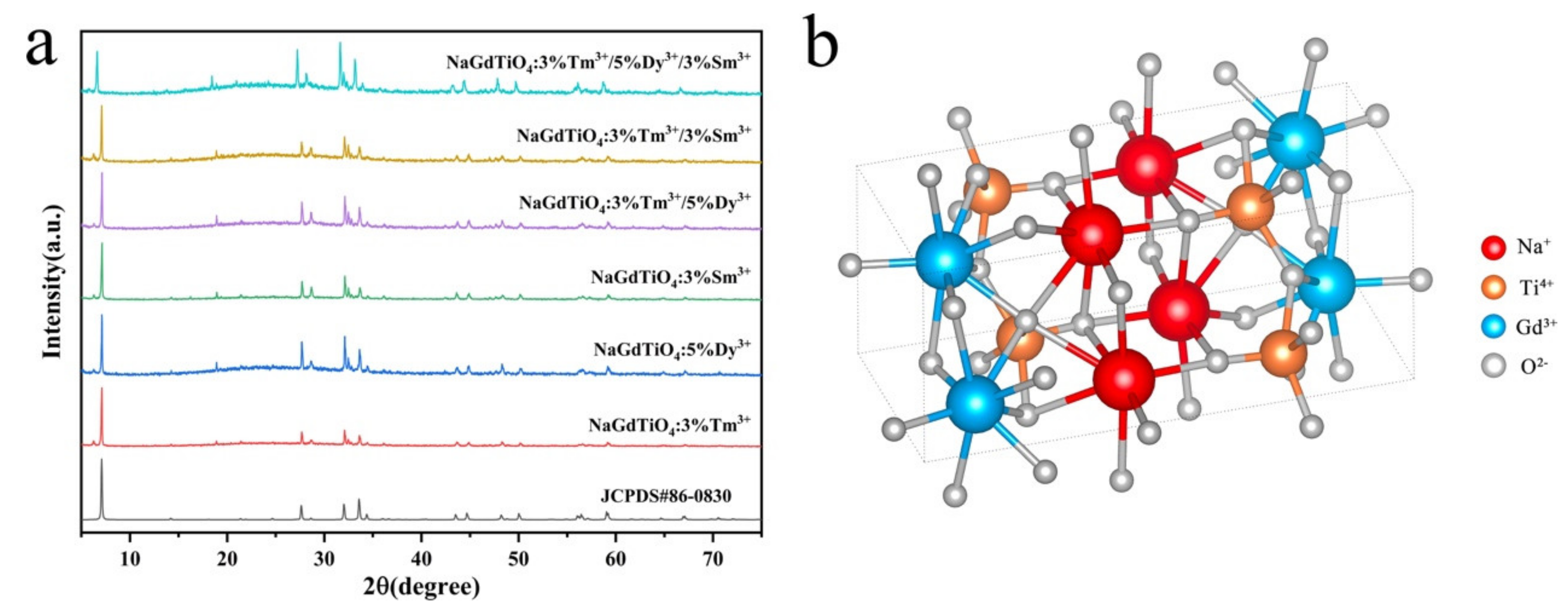
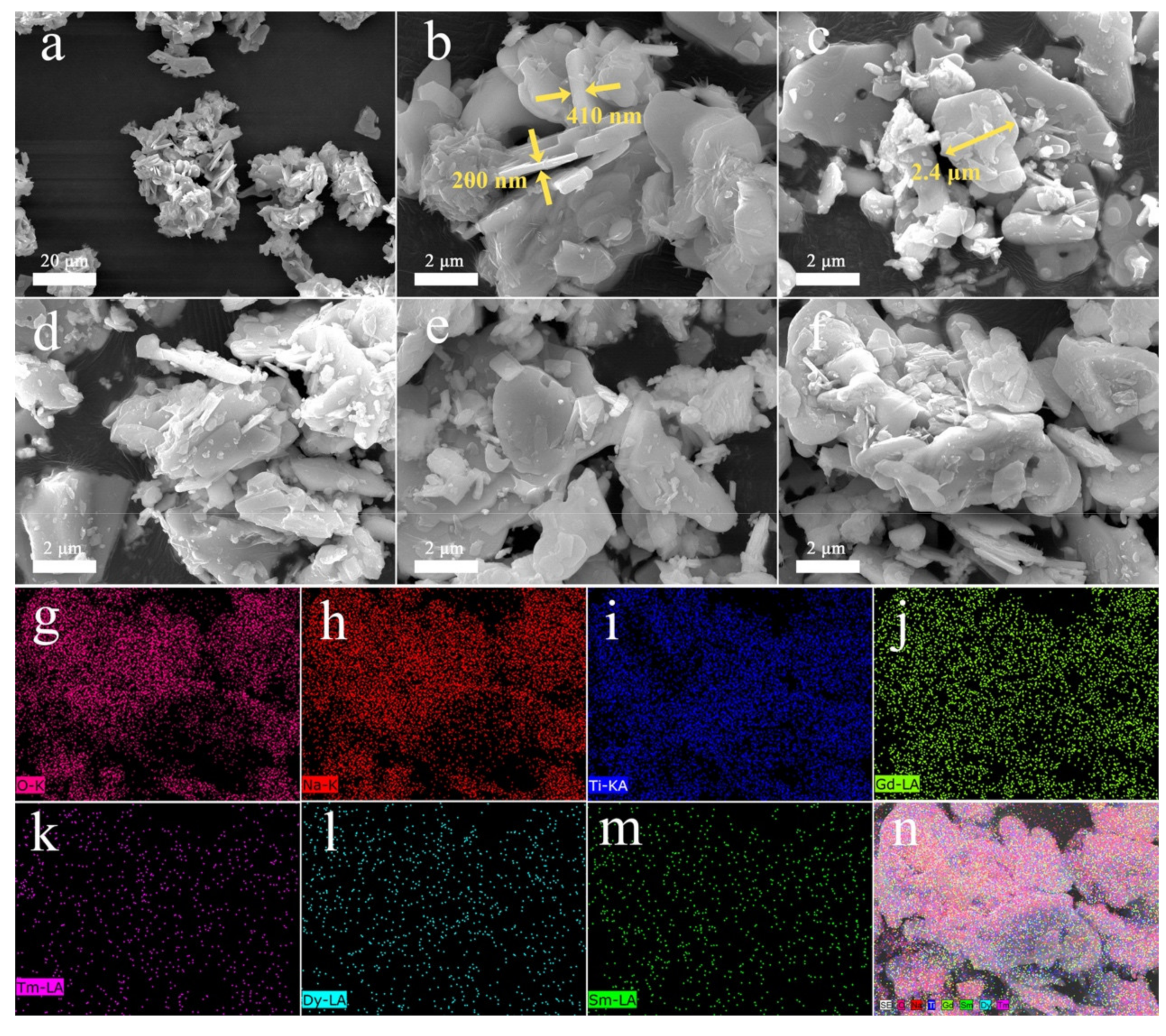
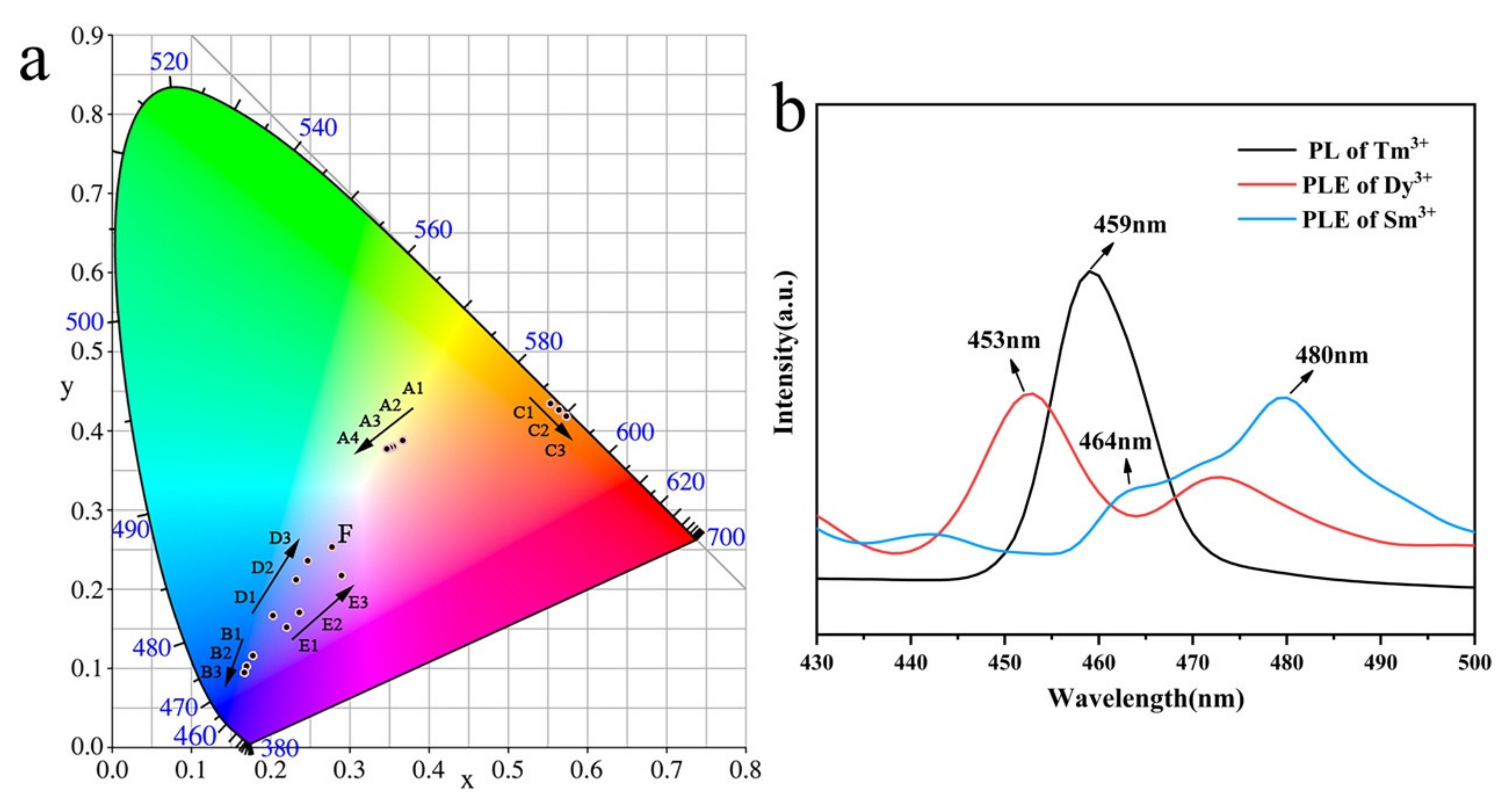
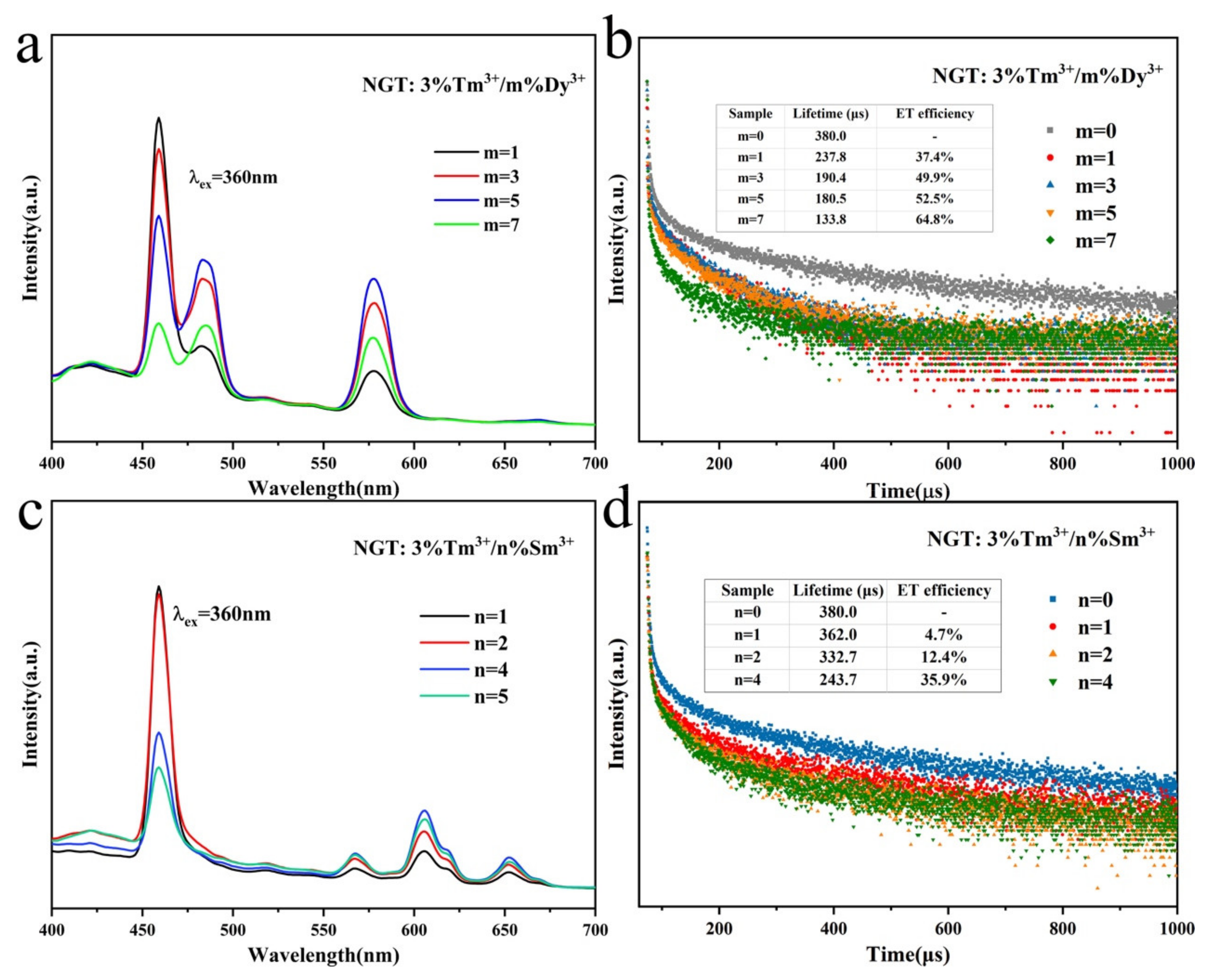


© 2020 by the authors. Licensee MDPI, Basel, Switzerland. This article is an open access article distributed under the terms and conditions of the Creative Commons Attribution (CC BY) license (http://creativecommons.org/licenses/by/4.0/).
Share and Cite
Xiao, J.; Wang, C.; Min, X.; Wu, X.; Liu, Y.; Huang, Z.; Fang, M. Multiple Energy Transfer in Luminescence-Tunable Single-Phased Phosphor NaGdTiO4: Tm3+, Dy3+, Sm3+. Nanomaterials 2020, 10, 1249. https://doi.org/10.3390/nano10071249
Xiao J, Wang C, Min X, Wu X, Liu Y, Huang Z, Fang M. Multiple Energy Transfer in Luminescence-Tunable Single-Phased Phosphor NaGdTiO4: Tm3+, Dy3+, Sm3+. Nanomaterials. 2020; 10(7):1249. https://doi.org/10.3390/nano10071249
Chicago/Turabian StyleXiao, Jun, Cong Wang, Xin Min, Xiaowen Wu, Yangai Liu, Zhaohui Huang, and Minghao Fang. 2020. "Multiple Energy Transfer in Luminescence-Tunable Single-Phased Phosphor NaGdTiO4: Tm3+, Dy3+, Sm3+" Nanomaterials 10, no. 7: 1249. https://doi.org/10.3390/nano10071249
APA StyleXiao, J., Wang, C., Min, X., Wu, X., Liu, Y., Huang, Z., & Fang, M. (2020). Multiple Energy Transfer in Luminescence-Tunable Single-Phased Phosphor NaGdTiO4: Tm3+, Dy3+, Sm3+. Nanomaterials, 10(7), 1249. https://doi.org/10.3390/nano10071249





